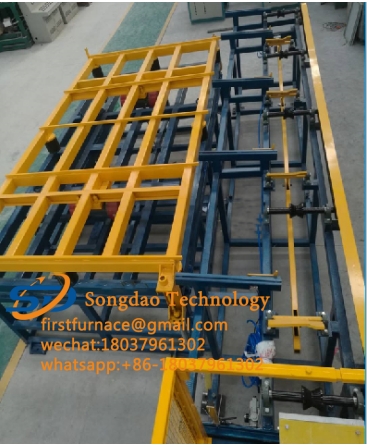- 03
- Sep
Steel bar quenching and tempering production line
Steel bar quenching and tempering production line

A. Advantages of steel bar quenching and tempering production line
1. The steel bar quenching and tempering production line can greatly shorten the steel bar quenching and tempering production cycle and improve the working conditions.
2. The steel bar quenching and tempering production line can improve the organization level of the steel bar quenching and tempering production and improve the product quality.
3. The induction heating equipment of the steel bar quenching and tempering production line saves materials more than the flame heating furnace, and at the same time improves the service life of the steel bar after quenching and tempering.
4. The steel bar quenching and tempering production line does not produce smoke and smoke due to induction heating, which purifies the working environment of the workshop.
5. The induction heating time of the steel bar quenching and tempering production line is short and the efficiency is high.
B. Overview of steel bar quenching and tempering production line
1. The steel bar quenching and tempering production line is controlled by a resonant intermediate frequency power supply, and the rectification is fully open to achieve high power.
2. Conveying roller table: The axis of the roller table and the axis of the workpiece form an angle of 18~21°, and the workpiece moves forward at a constant speed while autotransmitting, so that the heating is more uniform. The roller table between the furnace body is made of 304 non-magnetic stainless steel and water-cooled. The other parts of the roller table are made of No. 45 steel and surface hardened.
3. The roller table grouping of the steel bar quenching and tempering equipment: the feeding group, the sensor group and the discharging group are controlled by a separate frequency converter, which is beneficial to the uniform speed of the bar during the forward process.
4. Temperature closed-loop system: It adopts American Leitai infrared thermometer combined with German Siemens S7 to form a closed-loop control system, which can accurately control the temperature and heat more evenly.
5. The steel bar quenching and tempering equipment is controlled by an industrial computer, which displays the status of the working parameters at the time in real time, and functions such as workpiece parameter memory, storage, printing, fault display, and emergency signal activation.
6. The workpiece after quenching and tempering on the steel rod and tube production line has no cracks and no deformation, and the qualified rate of finished products is as high as 99%.
7. Parallel and series resonance intelligent control technology for steel bar quenching and tempering production line power supply, full touch screen digital operation induction heating quenching and tempering heat treatment equipment, is an international induction heating technology equipment.
C. Case study of steel bar quenching and tempering production line:
1. The steel bar quenching and tempering production line is used for the integral heating quenching and tempering of hydraulic rods and push-pull rods.
2. Parameters of steel bar quenched and tempered workpieces
1) Product material: 45# steel, 40Cr, 42CrMo
2) Product model (mm): Diameter: 60≤D≤150 (solid steel rod) Length: 2200mm~6000mm;
3) The steel bar is heated to the quenching temperature by intermediate frequency and then cooled for quenching treatment, and tempering treatment is performed on-line.
Quenching heating temperature: 950±10℃; Tempering heating temperature: 650±10℃;
4) Input voltage: 380V±10%
5) Output requirement: 2T/H (subject to 100mm steel bar)
D. Technical requirements for steel bar quenching and tempering production line:
1) The overall surface hardness of the entire shaft is 22-27 degrees HRC, the minimum hardness cannot be less than 22 degrees, and the appropriate hardness is 24-26 degrees;
2) The hardness of the same shaft must be uniform, and the hardness of the same batch must also be uniform, and the uniformity of a shaft must be within 2-4 degrees.
3) The organization must be uniform, and the mechanical properties must meet the requirements:
a. Yield strength is greater than 50kgf/mm²
b. Tensile strength is greater than 70kgf/mm²
c. Elongation is greater than 17%
4) The lowest point of the center of the circle shall not be lower than HRC18, the lowest point of 1/2R shall not be lower than HRC20 degrees, and the lowest point of 1/4R shall not be lower than HRC22 degrees.
E. Description of process flow of steel bar quenching and tempering production line
First, manually place the steel rods that need to be heated in a single row and a single layer on the feeding storage rack, and then the material is slowly sent to the feeding rack by the loading machine, and then the material is pushed into the feeding inclined roller by the air cylinder. The oblique roller drives the bar material forward and sends the material to the quenching heating inductor. Then the workpiece is heated by the quenching heating part, and the quenching heating is divided into quenching heating heating and quenching heat preservation heating. In the quenching heating part, a 600Kw intermediate frequency power supply is used to heat up the workpiece, and then two sets of 200Kw intermediate frequency power supplies are used for heat preservation and heating.
After the heating is completed, the workpiece is driven by the inclined roller to pass through the quenching water spray ring for quenching. After quenching is completed, it enters the tempering heating inductor for tempering heating. Tempering heating is also divided into two parts: tempering heating and tempering heat preservation. The heating part adopts 300Kw intermediate frequency power supply, and the heat preservation part adopts two sets of 100KW.
The steel bar and steel bar quenching and tempering production line selects high-performance and cost-effective solutions according to the process requirements proposed by the customer. The complete production line includes intermediate frequency heating equipment, mechanical conveying device, infrared temperature measurement device, closed water cooling system, and central control Box etc.
